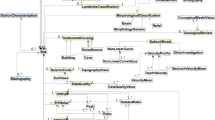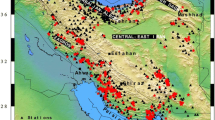Abstract
The last release of the strong-motion database ITACA (ITalian ACelerometric Archive v 2.1, http://itaca.mi.ingv.it) includes, to date, about 25,222 three-component accelerometric waveforms generated by 1365 earthquakes with magnitude between 3.0 and 6.9 and recorded by 1210 stations in the time frame 1972–2015. One of the main goals of ITACA is to improve the characterization of the recording sites from the geological and geophysical point of view and to provide seismic classification according to Italian seismic code. To this aim, metadata of recording stations are stored in three main thematic levels (topographic features, geological features and geophysical measurements) useful for a large variety of applications in engineering seismology or earthquake engineering. In particular, 206 recording stations have been characterized by quantitative measurements of velocity profiles, conducted through different techniques (active and/or passive), and the VS,30 values are available in ITACA 2.1. Moreover, 357 horizontal to vertical spectral ratios of Fourier spectra of ambient noise and the value of the fundamental frequency are also accessible. All details about the stations contained in the ITACA database are described in specific reports.








Similar content being viewed by others
References
Akkar S, Sandıkkaya MA, Senyurt M, Azari Sisi A, Ay BÖ, Traversa P, Douglas J, Cotton F, Luzi L, Hernandez B, Godey S (2014) Reference database for seismic ground-motion in Europe (RESORCE). Bull Earthq Eng 12:311–339. doi:10.1007/s10518-013-9506-8
Albarello D, Francescone M, Lunedei E, Paolucci E, Papasidero MP, Peruzzi G, Piaruccini P (2016) Seismic characterization and reconstruction of reference ground motion at accelerometric sites of the Italian national accelerometric network (RAN). Nat Hazards. doi:10.1007/s11069-016-2310-4
Ancheta TD, Darragh RB, Stewart JP, Seyhan E, Silva WJ, Chiou BSJ, Wooddell KE, Graves RW, Kottke AR, Boore DM, Kishida T, Donahue JR (2014) NGA-West2 database. Earthq Spectra 30(3):989–1005
Aoi S, Kunugi T, Fujiwara H (2004) Strong-motion seismograph network operated by NIED: K-NET and KiK-net. J Jpn Assoc Earthq Eng 4(3):65–74. doi:10.5610/jaee.4.3_65
BSSC (Building Seismic Safety Council) (2015) NEHRP: recommended provisions for seismic regulations for new buildings and other structures, 2003 Edition. Part 1—provisions, Part 2 commentary; prepared by the Building Seismic Safety Council for the Federal Emergency Management Agency (Report No. FEMA P-1050/2015 Edition): Washington, DC; 2004
Castellaro S, Mulargia F, Rossi PL (2008) Vs30: proxy for seismic amplification? Seismol Res Lett 79(4):540–543. doi:10.1785/gssrl.79.4.540
CEN (Comité Européen de Normalisation) (2004) Eurocode 8: design of structures for earthquake resistance—Part 1: general rules, seismic actions and rules for buildings, Comité Européen de Normalisation Brussels, May, http://www.cen.eu/cenorm/homepage.htm
Chávez-García FJ, Bard PY (1994) Site effects in Mexico City eight years after the September 1985 Michoacan earthquakes. Soil Dyn Earthq Eng 13:229–247
Chávez-García FJ, Stephenson WR, Rodríguez M (1999) Lateral propagation effects observed at Parkway, New Zealand. A case history to compare 1D versus 2D site effects. Bull Seismol Soc Am 89:718–732
Clinton J, Cauzzi C, Fäh D, Michel C, Zweifel P, Olivieri M, Cua G, Haslinger F, Giardini D (2011) The current state of strong motion monitoring in Switzerland. In: Earthquake data in engineering seismology: networks, data management and predictive models. Springer, pp 219–233
CS.LL.PP (2008) DM 14 Gennaio 2008. Norme Tecniche per le Costruzioni. Gazzetta Ufficiale della Repubblica Italiana, 29 (in Italian)
Di Capua G, Lanzo G, Pessina V, Peppoloni S, Scasserra G (2011a) The recording stations of the Italian strong motion network: geological information and site classification. Bull Earthq Eng 9:1779–1796. doi:10.6092/INGV.IT-CPTI11
Di Capua G, Peppoloni S, Amanti M, Cipolloni C, Conte G, Avola D, Del Buono A, Borgomeo E, Negri Arnoldi C, Scrivieri S (2011b) Il progetto SEE-GeoForm: uno strumento per la consultazione di dati geologici e di pericolosità sismica riferiti all’intero territorio nazionale. In: Proceedings of the XIV conference ANIDIS, Bari 18–22 September 2011
Di Giacomo D, Gallipoli MR, Mucciarelli M, Parolai S, Richwalski SM (2005) Analysis and modeling of HVSR in the presence of a velocity inversion: the case of Venosa, Italy. Bull Seismol Soc Am 95:2364–2372
Field EH (1996) Spectral amplification in a sediment-filled valley exhibiting clear basin-edge-induced waves. Bull Seismol Soc Am 86:991–1005
Kawase H (1996) The cause of the damage belt in Kobe: the basin-edge effect, constructive interference of the direct S-wave with the basin-induced diffracted/Rayleigh waves. Seismol Res Lett 67:25–34
Khazai B, Sitar N (2004) Evaluation of factors controlling earthquake-induced landslides caused by Chi–Chi earthquake and comparison with the Northridge and Loma Prieta events. Eng Geol 71(1–2):79–95
Lee VW, Trifunac MD (2010) Should average shear-wave velocity in the top 30 m of soil be used to describe seismic amplification? Soil Dyn Earthq Eng 30(11):1540–1549
Locati M, Gomez-Capera AA, Puglia R, Santulin M (2016) Rosetta, a tool for linking accelerometric recordings and macroseismic observations: description and applications. Bull Earthquake Eng (under review)
Lovati S, Bakavoli MKH, Massa M, Ferretti G, Pacor F, Paolucci R, Haghshenas E, Kamalian M (2011) Estimation of topographical effects at Narni ridge (Central Italy): comparisons between experimental results and numerical modeling. Bull Earthq Eng 9(6):1987–2005
Luzi L, Hailemikael S, Bindi D, Pacor F, Mele F, Sabetta F (2008) ITACA (ITalian ACcelerometric Archive): a web portal for the dissemination of italian strong-motion data. Seismol Res Lett 79(5):716–722. doi:10.1785/gssrl.79.5.716
Luzi L, Puglia R, Pacor F, Gallipoli MR, Bindi D, Mucciarelli M (2011) Proposal for a soil classification based on parameters alternative or complementary to VS,30. Bull Earthq Eng 9:1877–1898
Michel C, Edwards B, Poggi V, Burjánek J, Roten D, Cauzzi C, Fäh D (2014) Assessment of site effects in Alpine regions through systematic site characterization of seismic stations. Bull Seismol Soc Am 104(6):2809–2826. doi:10.1785/0120140097
Pacor F, Paolucci R, Luzi L, Sabetta F, Spinelli A, Gorini A, Nicoletti M, Marcucci S, Filippi L, Dolce M (2011) Overview of the Italian strong motion database ITACA 1.0. Bull Earthq Eng 9(6):1723–1739. doi:10.1007/s10518-011-9327-6
Paolucci R (2002) Amplification of earthquake ground motion by steep topographic irregularities. Earthq Eng Struct Dyn 31:1831–1853
Park D, Hashash YMA (2004) Probabilistic seismic hazard analysis with non linear site effects in the Mississippi embayment. In: Proceedings of the 13th world conference on earthquake engineering, Vancouver, Paper No 1549 (on CD-Rom)
Pessina V, Fiorini E (2014) A GIS procedure for fast topographic characterization of seismic recording stations. Soil Dyn Earthq Eng 63:248–258
Pischiutta M, Cultrera G, Caserta A, Luzi L, Rovelli A (2010) Topographic effects on the hill of Nocera Umbra, central Italy. Geophys J Int 182:977–987
Pitilakis K, Riga E, Anastasiadis A (2013) New code site classification, amplification factors and normalized response spectra based on a worldwide ground-motion database. Bull Earthq Eng 11(4):925–966
Puglia R, Albarello D, Gorini A, Luzi L, Marcucci S, Pacor F (2011) Extensive characterization of Italian accelerometric stations from single-station ambient-vibration measurements. Bull Earthq Eng 9:1821–1838. doi:10.1007/s10518-011-9305-z
Régnier J, Laurendeau A, Duval AM, Guéguen P (2010) From heterogeneous set of soil data to VS profile: application on the French permanent accelerometric network (RAP) sites. In: Proceedings of 14 EECE, Ohrid, 30 August–03 September 2010
Rial JA (1996) The anomalous seismic response of the ground at the Tarzana hill site during the Northridge 1994 Southern California earthquake: a resonant, sliding block? Bull Seismol Soc Am 86(6):1714–1723
Sandıkkaya MA, Yılmaz MT, Bakır BS, Yılmaz Ö (2010) Site classification of Turkish national strong-motion stations. J Seismol 14(3):543–563
Seed RB, Dickenson SE, Idriss IM (1991) Pricipal geotechnical aspects of the 1989 Loma Prieta earthquake. Soil Found 31(1):1–26
SESAME (Site effects Assessment using Ambient Excitation) European Project (2005) Deliverable D23.12, Guideline for the implementation of the HV spectral ratio technique on ambient vibration: measurement, processing and interpretation. http://sesame-fp5.obs.ujf-grenoble.fr/SES_TechnicalDoc.htm
Seyhan E, Stewart JP, Ancheta TD, Darragh RB, Graves RW (2014) NGA-West2 Site database. Earthq Spectra 30(3):1007–1024
Steidl JH (2000) Site response in southern California for probabilistic seismic hazard analysis. Bull Seismol Soc Am 90(6B):S149–S169
Stewart JP, Liu AH, Choi Y (2003) Amplification factors for spectral acceleration in tectonically active regions. Bull Seismol Soc Am 93:332–352
Wald DJ, Allen TI (2007) Topographic slope as a proxy for seismic site conditions and amplification. Bull Seismol Soc Am 97(5):1379–1395. doi:10.1785/0120060267
Acknowledgments
This work has been partially developed in the framework of S2 Project under the agreement between the Istituto Nazionale di Geofisica e Vulcanologia (INGV) and the Italian Civil Protection Department (DPC), although this paper does not necessarily represent DPC official opinion and policies. The Authors are grateful to Francesca Pacor for supporting and encouraging in the developing of this paper. S2-Task2 Working Group (S2 Project, Task 2 Working Group. Deliverable D2.1: Site-specific characterization of selected ITACA stations, https://goo.gl/eFfv91) is also acknowledged for the geophysical surveys carried out during the project; these investigations are fully described in S2 reports linked to the stations monographies on the ITACA web-page (see Appendix B of the D2.1, https://goo.gl/eFfv91).
Author information
Authors and Affiliations
Corresponding author
Rights and permissions
About this article
Cite this article
Felicetta, C., D’Amico, M., Lanzano, G. et al. Site characterization of Italian accelerometric stations. Bull Earthquake Eng 15, 2329–2348 (2017). https://doi.org/10.1007/s10518-016-9942-3
Received:
Accepted:
Published:
Issue Date:
DOI: https://doi.org/10.1007/s10518-016-9942-3




